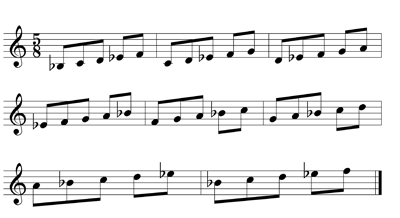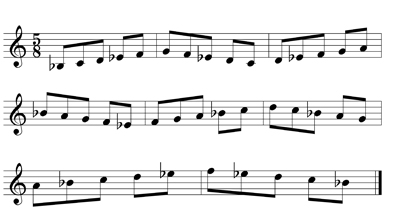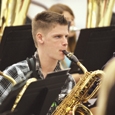Articulating low notes is perhaps one of the most difficult and frustrating aspects of playing the saxophone. Many students become easily discouraged while playing the lowest notes on the saxophone (written C4, B3, and Bb3.) They experience such unpleasant results as playing an octave too high, producing a fuzzy sound, or failing to make a sound at all. Furthermore, playing these notes can sometimes conjure anxiety and physical tension in the upper body. Younger students may not feel confident of the fingerings, because intermediate-level music rarely descends into this range. Unfamiliarity with the fingering causes a delay in tongue and finger coordination at the start of the note, which makes a clear articulation and tone nearly impossible for a note in this range. These factors greatly inhibit the chance for a clear articulation in this range. Here are perspectives on the extreme low range of the instrument from well-known saxophonists who perform and teach in a variety of genres.
Jeff Coffin
The lower (and higher) extremes of the saxophone present a number of difficulties, articulation not withstanding. I find that having the correct setup between the reed and mouthpiece is extremely important in getting the quickness of response in the low end. I take special care to make sure the reed is balanced side to side.
I use the entire range when I am playing and practicing patterns, scales, or just improvising freely. One technique I have found that works really well in the low register is playing scales in five-note groupings.

This should be continued throughout the whole range of the instrument and in every key.
Another good exercise is something I call stair stepping, which is going up and coming down the same five-note sequence.

These exercises can also be used with the harmonic minor scale as well as the ascending melodic minor scale, both of which produce cool results and interesting-sounding lines. I recommend articulating the second and fourth notes, especially in the low register. I like this exercise because it not only covers the whole instrument but also forces me to articulate in a way that is not in 44. It changes the way I phrase, and that’s a good thing. For more information or to ask questions, please visit www.jeffcoffin.com. Jeff Coffin is a saxophonist, composer, educator, and Grammy Award winner who plays with the Dave Matthews Band, Bela Fleck & the Flecktones, and the Jeff Coffin Mu’tet.
Branford Marsalis
My concepts on low note articulation are gleaned from my teacher, Harvey Pittel, and some time spent with Dale Underwood. On notes below low E moving the mouthpiece slightly outward decreases the amount of reed vibration, thus creating less sound. In addition, I try to feel the air glancing slightly above the tip of the reed, and toward the top of the mouthpiece. Also, I crane my neck slightly forward so as to really feel the air column flowing upward towards the tip of the mouthpiece. Additionally, it helps to lower the jaw slightly, which creates a larger chamber for the air to circulate in. This combination works well for me.
Branford Marsalis is a Grammy Award-winning jazz and classical recording artist, performer, and educator.
Jason Kush
First and foremost, it is important to remember the basic principles of saxophone tone production, which include air (speed, amount, and direction), voicing, and embouchure. Each of these includes several internal variables with which players should experiment to achieve the goal of clarity and control.
A primary issue that comes to mind with regard to low register articulation is pressure around the mouthpiece. The term pressure does not imply a tight embouchure, I am simply drawing attention to the degree of grip onto the mouthpiece. The bottom lip should be supportive against the reed, but free enough for the reed to vibrate at the given frequency. To keep this support and maintain freedom, release the top lip from the mouthpiece, as though snarling. An old Joe Allard technique, releasing the pressure on top, will, in turn, release the bottom pressure as well as free the side rails of the reed to maximize vibration.
To play low, it is necessary to think low but still move air quickly into the saxophone with a moderate ee tongue position. An oo position is the most open, as to match the lowness of the note, but will not provide the air speed and direction necessary to have the note speak. Having the tongue in a very low position is useless in saxophone playing.
At this point, I suggest that saxophonists practice articulating low Cs, Bs, and B flats with a snarled upper lip, a medium amount of fast air, and a moderate ee tongue position. If players can make a clear articulation using these elements, the addition of proper tongue technique will make this much easier. As saxophonists begin to practice this, they will likely have a bobble to the note and then the note will become full. This is evidence that students can automatically make an adjustment to allow the pitch to vibrate in its most efficient manner. What saxophonists must do is try to figure out how they are making that adjustment, then anticipate having to do that when articulating.
As for tonguing, a minute adjustment must be made in comparison to tonguing in the other registers. As a general principle, players should tongue with the tongue touching slightly more of the reed in the low register and less of the reed in the high register. This could also be conceived as tonguing further away from the tip of the tongue. In any case, the reed is to be released in a non-percussive manner as not to produce a slap tongue. A d tonguing position combined with an ee tongue position will help in production of a clear articulation. The word “deep” is an excellent memory device for this.
Jason Kush is professor of saxophone at Slippery Rock University of Pennsylvania.
Connie Frigo
Articulating low notes requires the same technique as articulating all other notes on the saxophone. As though saying the syllable dih or dah, the upper side of the tip of the tongue lightly flicks the tip of the reed, about 1⁄8" back from the actual tip of the reed. The tongue is forward and the tip moves in an up-and-down motion to strike the reed versus a front-and-back motion. Avoid striking the tip of the reed head on; you will know if you are doing this because the tongue will feel the opening between the tip of the mouthpiece and the reed. This articulation method should be applied across the board regardless of which saxophone is being played or which range of notes is being articulated.
The less obvious culprit in poor low note response is often a lack of fast, focused air through the horn. Low notes need more air. When playing low notes, or any notes, for that matter, avoid any loosening of the embouchure, and be careful to avoid accidentally using more surface area of the tongue to articulate. Anxiety and physical tension can frequently cause players to decrease air support out of fear of honking the low notes. This worsens the problem. Lack of air, coupled with embouchure manipulation and improper tonguing technique, will cause poor low note response and control. The combination of proper tonguing technique with faster, focused air will allow a controlled sound that should be created as effortlessly as any note on the horn.
Connie Frigo is professor of saxophone at the University of Maryland and baritone saxophonist of the New Century Saxophone Quartet.
Arno Bornkamp
With a normal embouchure it is important to have extremely strong air support, enough pressure on the reed of the lower jaw, and a good resonance. I like to work on these things with students by using mouthpiece exercises. I like to minimize the tongue action in articulations as much as possible to avoid interrupting the airflow. For a real pianissimo in the low register it is effective to use a double-lip embou-chure, however, the timbre of the sound will be a subtone.
Arno Bornkamp is saxophone professor at Conservatorium van Amsterdam and an international soloist.
Tim Ries
When articulating in any register of the saxophone, it is important to remember that articulation does not come from hitting the reed with the tongue. Tonguing occurs when you release the tongue from the reed, especially at the beginning of the phrase. When you have sufficient breath support, with the tongue on the reed, release the tongue for the beginning of the note. This enables the player to produce the desired pitch, in any register, with less attack on the note.
Tim Ries plays with the Rolling Stones and is a jazz recording artist, arranger, composer, and producer.
Kenneth Tse
Confidence is key when tonguing in the low register, regardless of the dynamic level. To be confident, one must learn to feel and imagine how the tongue is maneuvering. Imagination is the key word here. I suggest a brief study of articulatory phonetics (it is the study by phoneticians of how humans produce speech sounds through the interaction of different physiological structures). The knowledge of places or points of articulation inside the mouth is vital in the understanding of optimum tonal projection as well as effective tonguing.
Confront the problem. Students should not use key pops or other tricks to help with low-note tonguing, at least in the beginning. Learn to tongue correctly and continue to practice until mastery is achieved. It is okay if the low notes sound loud or harsh at first. The objective is to get accustomed only using the tongue to obtain total control on low notes. Otherwise, the beginning of Alfred Descenclos’s Prelude, Cadence et Finale will always induce anxiety.
To start low notes, avoid having the tongue flat on the reed and making the angle of attack vertical (up and down). Slap-tonguing technique can make it easy to fall into both of these habits. The tip of the tongue should not touch the reed and then release because a slap sound would most likely happen. Instead, imagine that the tongue is curved and positioned at a 45-degree angle and touch the reed in a forward-and-backward motion. It is unimportant whether the tongue is actually moving exactly that way; visualization simply helps students produce the action. This action is, however, actually quite drastic; students should feel that the whole tongue is pulling back when starting the note.
When tonguing, instead of worrying about touching the reed, focus on touching the alveolar ridge (the raised area right behind the top front teeth) using the middle part of the tongue, which also raises the back of the tongue. Then think of saying taw and pull back the tongue. A part of the tongue will touch the reed to create the articulation, but it should be as light as possible. Most of the pressure should be on the alveolar ridge. Tonguing against the alveolar ridge is the sure way to avoid slap sounds and harsh attacks.
If students consistently produce the note with an undesirable octave partial, have them focus on where the tongue is after tonguing and on the shape of the oral cavity; improper formation may cause too fast an air stream. In general, it should be quite open after starting the note with the tongue close to the floor.
The dynamics are then controlled by the distance between the reed and the middle of the tongue. Do not aim at perfection in the beginning. The initial goal is to tongue, produce, and sustain a low note clearly and confidently without hesitation or unwanted noises. Good control in speed and at different dynamic levels will come with persistent and thoughtful practice sessions.
Kenneth Tse is professor of saxophone at the University of Iowa and an international soloist.
Claude Delangle
(Translated by Matt Taylor)
The low register of the saxophone provides the instrument with its richness of sound but also causes many of the instrument’s acoustic problems. All of the sound potential of an instrument rests in its fundamental notes; it is in the low register that one can hear the richness of the harmonic spectrum. Saxophonists play with these fundamentals to play overtones and altissimo notes. We also know that the bell’s shape is extremely important to the sonority of low notes, and indeed to all the notes through the altissimo register.
Ultimately, the manufacturing of the instrument affects not only the low register notes, but all of the notes. In an instrument, all registers are linked, so one cannot easily talk about a register without talking about the entire instrument. Nevertheless, the baritone saxophone should be distinguished from the others in the saxophone family. Its low register is proportional to its size, and low notes on this instrument are much more natural sounding and easy to produce compared with other members of the family.
The richness of the low registers of the other members of the saxophone family is essentially a function of its large conical bore, which produces an extremely full harmonic spectrum. The difficulty associated with playing the lowest notes is therefore a genetic trait of the instrument’s acoustics. This difficulty is most evident when playing piano or softer, when the fundamental and the first and second partials are all equally likely to sound.
To solve this problem, saxophonists, especially jazz saxophonists, tend to play in a subtone, which allows them to play the fundamental exclusively, and with beauty. Today, with the necessities of an increasingly demanding repertoire, classical saxophonists have developed a variety of subtone techniques that deliver the fundamental with ease, and can offer a range of sounds from totally subtone (détimbré) in which only the fundamental is heard, to a quality of sound with varying numbers of harmonics. These classical subtones are more refined than those used in jazz, and offer more flexibility and control.
Still, playing in the low register remains a great difficulty for saxophonists and will take a great deal of time to master, especially while playing staccato. Saxophonists must not forget that the action of the tongue must adapt to each register. For playing a high or altissimo note, the contact between the tongue and the reed should be extremely light so that it does not interfere with the vibration and result in a cracked note, whereas for a low note it is the opposite. The attack of the tongue must be firm on the reed, and cover more of the reed’s surface. This is why the slap tongue is easier to produce in the low register.
Claude Delangle is saxophone professor at National Superior Conservatory of Music in Paris, France, and an international soloist.
It is evident that many concepts exist to teach this often difficult area of saxophone sound production. Assisting students to develop a method, drawn from these master teachers, will allow for a successful articulation and pure tone in this register of the instrument.






